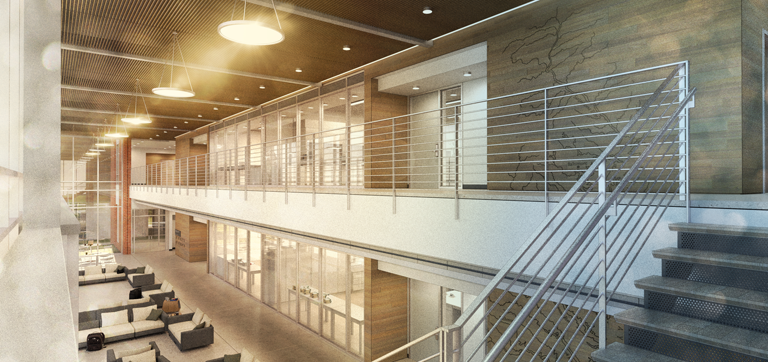Share this Story
Inside Story
Art history students get architectural perspective on the College's forthcoming Greer Environmental Sciences Center
 Oohs and aahs drifted from professor Joyce Howell’s “Art History” classroom recently as Joe Atkins of VMDO Architects shared a special behind-the-scenes look at the firm’s processes and planning for Virginia Wesleyan’s forthcoming Greer Environmental Sciences Center. Fully funded by an anonymous donor, the nearly 40,000-square-foot academic facility is set for completion by fall 2017.
Oohs and aahs drifted from professor Joyce Howell’s “Art History” classroom recently as Joe Atkins of VMDO Architects shared a special behind-the-scenes look at the firm’s processes and planning for Virginia Wesleyan’s forthcoming Greer Environmental Sciences Center. Fully funded by an anonymous donor, the nearly 40,000-square-foot academic facility is set for completion by fall 2017.
Atkins started at the beginning, recalling details about the project’s secretive bidding process and the surprise announcement at the May retirement celebration for then President William T. “Billy” Greer. He spoke of the emotion he and his colleagues felt in that moment and their gratitude to be a part of this formative time in the College’s history.
“It was a pretty great moment in an architect’s career to sit on the sidelines and see appreciation for the work and the dream of this building,” he said.
Rough sketches and brainstorming scribbles gave students and guests a new perspective on the center, with glimpses of the many possibilities considered before arriving at the final design.
Atkins spoke about materials chosen for the building—including a reclaimed cypress wood pulled from the Mississippi River—and presented early interior renderings featuring the fully glazed walls on the north side of the classroom laboratories that will encompass “science on display” and expose scientific exploration.
“We see this as a hub of activity,” said Atkins. “This space will be home to lots of events and symposia, bringing together a number of organizations and groups that we could see gathering here.”
The building’s collaborative, student-centered learning environment will also tell the Virginia Wesleyan story, Atkins shared. His sentiment was an excellent "teachable moment" for students, said Professor of Art History Joyce Howell.
“Experiential learning, the environmental sciences—these are values of the Virginia Wesleyan culture," she explained. "The building expresses us as a culture. Everything he said about the design, he connected it with those big ideas, like experiential learning, student collaboration, the environment, the Chesapeake Bay. This is our language, that’s anthropologically who we are as a culture.”
Learn more about the Greer Environmental Sciences Center.

